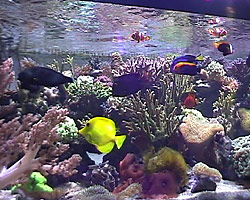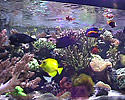 This aquarium has been running for the last two years (since December 2000). It started as a pure 190 Gallons Berlin system, with an overflow, a sump, a skimmer, 320 lbs of live rocks, an inch of coral gravel, 2 x 250W metal halides, actinic tubes, and 13 powerheads.
This aquarium has been running for the last two years (since December 2000). It started as a pure 190 Gallons Berlin system, with an overflow, a sump, a skimmer, 320 lbs of live rocks, an inch of coral gravel, 2 x 250W metal halides, actinic tubes, and 13 powerheads.
Editor’s Note: There are more photos of this month’s Feature Aquarium in the article’s Photo Album.
This configuration changed bit by bit. Today a 50 Gallons (200 liters) refugium (fluorescent lights, 20 lbs of live rocks, 9″ of oolitic sand, 100 GPH of flow with the main system) has been setup. A tunze Stream 6080 (pulsing 2,250 GPH) and a 1,300 GPH powerhead (used only during daylight) provide water flow. Coral sand has been added in the display tank and the substrate is now about 4″.
Calcium and alkalinity are maintained using two types of equipment. The first one is a calcium hydroxide reactor (Nilsen reactor), reloaded every week with four spoons and set as a permanent drip into the sump, near the return pump’s input (it may find some extra CO2 there). The second equipment is a 2-liter DIY calcium carbonate/CO2 reactor, set at 2 bubbles per second and controlled by a pH-meter and a solenoid valve. Its effluents are dripped next to the skimmer’s output, which should provide a good mix and a better stabilization of the pH.
Evaporation is compensated using a tunze float valve and a 34 Gallons (130 liters) reverse osmosed water reserve.
An Eheim 1060 pump (580 GPH) provides the return flow.
The overflow uses two pipes of different lengths, and a ball valve. The first pipe has its valve set so that the overflow’s water level just reaches above its extremity. This provides silence of operations. The second pipe, without any valve, has its extremity above the water level, and provides security if anything happens to the first.
A feature of this aquarium resides in its location in the basement. This has many advantages: strong floor, no carpet accidents, no direct sunlight, no noise or smell in the living room, no size limitations, the place can be a mess, the glass dirty, guaranteed temperature stability without a chiller, quiet environment for its inhabitants, increased Wife Acceptance Factor, and the possibility to invert the daylight cycle.
In France, electricity is much cheaper during the night, so the aquarium has its lights running from 7 PM to 6 AM.
Difficulties
My main struggle was with nitrates. Their level never ceased to increase in my aquarium. I followed multiple tracks: over-feeding, over-skimming, under- skimming, not enough return flow, not enough live rocks, flow, foam pads not cleaned regularly enough, old reverse osmosis membrane, old tests, too much sediments… I applied some fixes: less food, rinsed food, removal of foam pads, and switch to bare-bottom for the sediments fight, glucose injections, and addition of a deep sand bed... Despite all this, my nitrate level reached 120 mg/l
I wasn’t that worried, as no animal seemed to suffer from this situation. It is impossible to know how they would have been under other conditions, but their growth was good as well as their colors.
Nevertheless, I decided to reverse the trend. I built a 10-liters (2.6 Gallons) sulfur denitrator. It brought the nitrates concentration back to 5 mg/l. It was then removed and has never been used again.
These last few months, nitrates were coming back again. I decided to change my skimmer, from a single pump, venturi driven, Aquavie PS900 to a dual pump, needle wheel driven, H&S 200-2×1060. I hope this works; this is the last of my ideas.
Maintenance
I feed the aquarium every other day with 2 cubes of frozen food (brine shrimps, krill, and mysis) and a thawed silver side. Lettuce is given every week to the herbivores. The refugium benefits from a mussel, thousands of critters just rush to it.
I do not add any complements, like iodine or trace elements.
I do not perform regular water changes. They just occur during maintenance, when I vacuum the sediments in the sump for example.
I do complete equipment clean-ups about every six months. I soak the skimmer, pumps, reactors, etc… in a 13 Gallons tub full of water and two cups of 33% acid. This way I clean everything in two or three rounds, which doesn’t leave the aquarium hanging without anything running.
Dimensions
The display tank is 63″ x 31.5″ x 25.6″ (160 x 80 x 65 cm), about 220 Gallons (832 liters). The fresh water reserve is holds 34 Gallons (130 liters). The sump holds about 21 Gallons (80 liters) during normal operations. The refugium holds 50 Gallons (200 liters), has flow provided by a maxi-jet, and a return to the display tank provided by another maxijet.
Water flow is 3,160 GPH (12,000 l/h) by night and 4,200 GPH (16,000 l/h) by day.
Lighting is provided by an Aquaconnect UFO Classic Plus, 2x 250 W, Ushio double-ended 10,000K bulbs for 10 hours per day, and actinic tubes for 12 hours per day.
Population
- Fish
- 2 Amphiprion ocelaris
- 2 Amphiprion frenatus
- 3 Dascyllus uranus
- 1 Paracanthurus hepatus
- 1 Zebrasoma flavescens
- 1 Ctenochaetus strigosus
- 1 Pseudocheilinus hexetaenia
- 1 Halichoeres marginatuso
- Other invertebrates
- 6 hermit crabs XXL
- 2 serpent stars XXL
- 1 Lysmata debelius
- 2 Lysmata amboinensis
- 1 Stenopus hispidus
- 1 long-spine black urchin
- 1 grey sea cucumber
- 1 tipicus star fish
- Corals
- Numerous Acropora sp
- Euphyllia ancora
- Stylophora pistillata green, blue
- Pocillopora sp. pink
- Montipora red, yellow
- Galaxea sp.
- Discosoma spp
- 3 Tridacnid clams
- Turbinaria Peltata
- Seriatopora sp.
- Sinularia sp.
- Yellow polyps
- Sarcophyton sp.
- Welso sp.
- Clavularia sp.
- Plerogyra sp.
- Violacea sp.
- Caulastrea sp.
Parameters:
- Ca: 410 mg/l
- KH: 6
- NO3: 20 mg/l
- pH: 7.8-8
- Temperature: 26 °C
Conclusion
This hobby presents a unique opportunity to mix various competence domains: closed ecosystems, biology, electricity, chemistry, optics, physics, photography, to name just a few. It creates as well a “network” of persons, bringing a wealth of knowledge. They are a key to success. Some of these persons became personal friends and can be accepted as important contributors to the success of my reef aquarium. I wish to thanks them here. There are some quests from which you return with way more than what you were looking for…
The first quality of an aquarium is not to give its owner a nice decoration and a few frags. It teaches patience, philosophy, and increases the ability to accept failures and delay.
The aquarist brings the canvas, sets up the easel, and draws the basic shapes. But as time goes, he has to step aside and give the brush to Mother Nature. Seeing a lot of personal efforts heavily modified by Her can be agonizing, but it is generally a source of wonder.
Finally, patience is the only element that comes for free in this hobby.
Links
- Lights – Aquaconnect UFO Classic Plus
- Skimmer – Aquavie PS900
- Skimmer – H&S 200-2×1060
- Pump – Eheim 1060
- Pump – Tunze Turbelle Stream 6080
- Nilsen calcium reactor
This extra eye candy is proposed in Real Media and should be playable on any platform. Broadband (aDSL, cable) recommended.
Julien’s tank and his next project (a 316G reef) can be seen on his web site, The Big Faille.
—
- The Big Rift, as the initial aquascaping was an attempt at creating a rift.














0 Comments